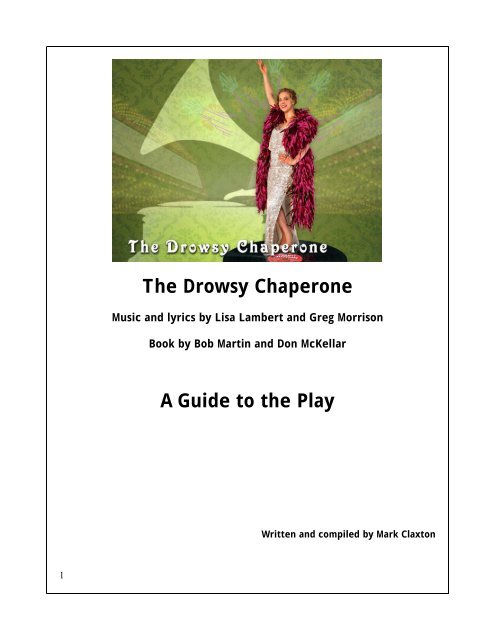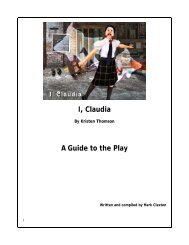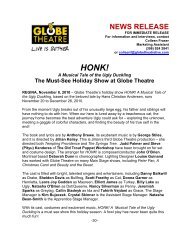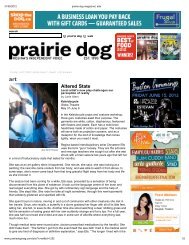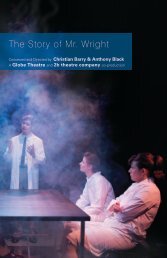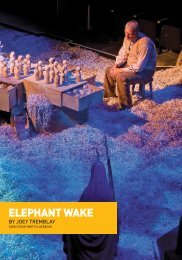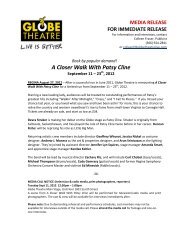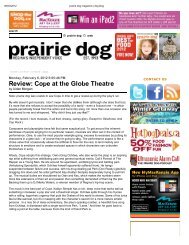The Alice Nocturne: An Adventure in Two Acts - Globe Theatre
The Alice Nocturne: An Adventure in Two Acts - Globe Theatre
The Alice Nocturne: An Adventure in Two Acts - Globe Theatre
You also want an ePaper? Increase the reach of your titles
YUMPU automatically turns print PDFs into web optimized ePapers that Google loves.
<strong>The</strong> Drowsy Chaperone<br />
Music and lyrics by Lisa Lambert and Greg Morrison<br />
Book by Bob Mart<strong>in</strong> and Don McKellar<br />
A Guide to the Play<br />
Written and compiled by Mark Claxton<br />
1
Contents<br />
How to use this guide .......... 3<br />
A history of the play .......... 4<br />
<strong>The</strong> Jazz Age ....... 5<br />
Meet the artistic team .......... 6<br />
Synopsis .......... 8<br />
Discuss and explore .......... 10<br />
2
How to Use This Guide<br />
This guide is <strong>in</strong>tended for anyone who would like to enhance their appreciation and<br />
understand<strong>in</strong>g of the <strong>Globe</strong> <strong>The</strong>atre's production of <strong>The</strong> Drowsy Chaperone. <strong>The</strong> guide<br />
conta<strong>in</strong>s background <strong>in</strong>formation about the play, an <strong>in</strong>troduction to the <strong>Globe</strong>'s<br />
artistic team, a summary of the action <strong>in</strong> each scene, a few questions <strong>in</strong>tended to<br />
encourage open-ended discussion, and some l<strong>in</strong>ks to additional resources for those<br />
who wish to explore further.<br />
Some of this guide's content may give you <strong>in</strong>formation about the play's plot that you'd<br />
rather discover yourself while experienc<strong>in</strong>g the show. If you'd like to avoid any<br />
potential spoilers, you might want to wait until see<strong>in</strong>g the play before read<strong>in</strong>g any<br />
further.<br />
Teachers who are prepar<strong>in</strong>g their students to experience the play can provide them<br />
with this guide's discussion questions ahead of time -- or first allow them to see the<br />
production and then use the questions or other sections of the guide to facilitate<br />
further thought and discussion.<br />
I hope this guide is both helpful and enjoyable to read. I welcome your comments and<br />
suggestions at mark.claxton@me.com.<br />
3
A history of the play<br />
Pre-wedd<strong>in</strong>g stag parties have a reputation for occasional short-term after-effects;<br />
the 1997 stag party of Canadian actors Bob Mart<strong>in</strong> and Janet Van De Graaff, however,<br />
produced a remarkable and endur<strong>in</strong>g legacy – one of the most critically and popularly<br />
acclaimed musicals of recent decades.<br />
<strong>The</strong> Drowsy Chaperone began life as a musical spoof created by a few of the couple's<br />
friends – Don McKellar, Lisa Lambert, and Greg Morrison – and performed at their stag<br />
party. <strong>The</strong> piece was such a hit, though, that the groom signed on as a co-writer for a<br />
version that would go to the Toronto Fr<strong>in</strong>ge Festival.<br />
When em<strong>in</strong>ent theatrical producer David Mirvish saw <strong>The</strong> Drowsy Chaperone's fr<strong>in</strong>ge<br />
production, he put up the money to stage it at Toronto's <strong>The</strong>atre Passe Muraille.<br />
Audiences <strong>in</strong> the relatively small theatre loved the show and Mirvish was <strong>in</strong>spired to<br />
f<strong>in</strong>ance a further expansion <strong>in</strong> a still larger venue – the W<strong>in</strong>ter Garden <strong>The</strong>atre.<br />
By this time, four years had passed s<strong>in</strong>ce the fateful stag party. But <strong>The</strong> Drowsy<br />
Chaperone was just gett<strong>in</strong>g started. New York producer Roy Miller came to see the<br />
W<strong>in</strong>ter Garden <strong>The</strong>atre show and immediately purchased the rights to br<strong>in</strong>g it to the<br />
Big Apple.<br />
On May 1, 2006, <strong>The</strong> Drowsy Chaperone opened on Broadway to audience raves and<br />
critical applause. Dur<strong>in</strong>g its run, it won five Tony Awards, <strong>in</strong>clud<strong>in</strong>g Best Book and<br />
Best Orig<strong>in</strong>al Score. <strong>The</strong> play has s<strong>in</strong>ce been staged <strong>in</strong> Toronto, London, Japan,<br />
Australia, and by a grow<strong>in</strong>g number of theatres across Canada and the United States.<br />
4
<strong>The</strong> Jazz Age<br />
<strong>The</strong> Drowsy Chaperone is an affectionate send-up of the Broadway musical –<br />
particularly that style of musical that predom<strong>in</strong>ated <strong>in</strong> the 1920s. While you could<br />
argue that stage musicals have never specialized <strong>in</strong> plot or character development,<br />
the “Jazz Age” musical was especially frothy, with a heavy emphasis on recycled,<br />
romantic storyl<strong>in</strong>es draped <strong>in</strong> lavish spectacle and high-energy song-and-dance.<br />
Like the popular art of any era, the musical of the “Roar<strong>in</strong>g Twenties” was a<br />
reflection of its times. <strong>The</strong> devastations of the First World War and the Spanish Flu<br />
pandemic were still fresh <strong>in</strong> the m<strong>in</strong>ds of North Americans; at the same time, the<br />
cont<strong>in</strong>ent was embark<strong>in</strong>g on a new era of prosperity and predom<strong>in</strong>ance on the world<br />
stage. <strong>The</strong> economy was boom<strong>in</strong>g, the stock market was soar<strong>in</strong>g, and a good number<br />
of people were becom<strong>in</strong>g very rich – and not always legally. When prohibition<br />
legislation outlawed the purchase and sale of alcohol, an underground network of<br />
gangsters, bootleggers and rum-runners was only too happy to profit from a thirsty<br />
market.<br />
Young adults of the 1920s were witnesses and survivors of war and disease. <strong>The</strong>y<br />
seemed determ<strong>in</strong>ed to embrace life; at the same time, they were well aware of its<br />
darker corners, and their value systems and rejection of many traditions was a<br />
complex mix of heady optimism and deep-rooted cynicism. Writers such as Ernest<br />
Hem<strong>in</strong>gway depicted aimless characters hurl<strong>in</strong>g themselves <strong>in</strong>to the pleasures of<br />
travel, romance, w<strong>in</strong><strong>in</strong>g, and d<strong>in</strong><strong>in</strong>g, and yet unable to escape an empt<strong>in</strong>ess at their<br />
core.<br />
Broadway audiences, however, were not <strong>in</strong>terested <strong>in</strong> see<strong>in</strong>g their demons on the<br />
stage. <strong>The</strong>y embraced and demanded more bright lights, exhilarat<strong>in</strong>g music, slapstick<br />
comedy, and fairy-tale romance. <strong>The</strong> Jazz Age musical, as the Man <strong>in</strong> Chair rightly<br />
po<strong>in</strong>ts out, was an escape, a getaway, a temporary reprieve from the pressures and<br />
problems of modern life.<br />
Interest<strong>in</strong>gly, stage musicals have made a remarkable comeback <strong>in</strong> popularity <strong>in</strong> the<br />
past two decades. While many of the genre's endur<strong>in</strong>g works feature darker themes<br />
than the typical 1920s fare, Broadway and Broadway-style musicals still harness the<br />
power of music and spectacle to usher their audiences <strong>in</strong>to an alternative universe.<br />
Even with the mockery and cynicism rest<strong>in</strong>g at its core, <strong>The</strong> Drowsy Chaperone has<br />
succeeded because its audiences leave the theatre smil<strong>in</strong>g. In true 1920s fashion, the<br />
show refuses to take itself seriously and is unabashedly, relentlessly fun.<br />
5
Meet the artistic team<br />
Robb Paterson (Director) has been Associate Artistic Director at the Royal Manitoba<br />
<strong>The</strong>atre Centre s<strong>in</strong>ce 2004. Over the past 31 years, he has been <strong>in</strong>volved <strong>in</strong> more than<br />
150 productions across Canada.<br />
Michael Scholar Jr. (Assistant Director) is <strong>Globe</strong> <strong>The</strong>atre's Artistic Associate. Born and<br />
raised <strong>in</strong> Reg<strong>in</strong>a, Michael tra<strong>in</strong>ed <strong>in</strong> the University of Reg<strong>in</strong>a’s <strong>The</strong>atre Department<br />
before graduat<strong>in</strong>g with a BFA <strong>in</strong> Act<strong>in</strong>g from the University of Alberta.<br />
Stephanie Graham (Choreographer) recently completed three seasons as the<br />
Director/Choreographer of the Young Company at the Charlottetown Festival. She<br />
also choreographed Next to Normal (directed by Robb Paterson) at the Manitoba<br />
<strong>The</strong>atre Centre.<br />
Brian Perchaluk (Set Designer) was born and raised <strong>in</strong> rural Manitoba and graduated<br />
from the University of W<strong>in</strong>nipeg and the National <strong>The</strong>atre School of Canada. Over the<br />
last 25 years, his designs have been featured on stages across the country.<br />
Emma Williams (Costume Designer) is a w<strong>in</strong>ner of the 2009 Olivier Award for her work<br />
on the Royal Shakespeare Company's productions of Henry IV Parts I & II and Henry V.<br />
She is the <strong>Globe</strong>'s resident costume designer for the 12|13 Ma<strong>in</strong> Stage season.<br />
Scott Henderson (Light<strong>in</strong>g Designer) is the resident light<strong>in</strong>g designer at W<strong>in</strong>nipeg's<br />
Ra<strong>in</strong>bow Stage. He has worked as a light<strong>in</strong>g designer for the Shaw Festival and been a<br />
sessional lecturer, teach<strong>in</strong>g design students at the University of W<strong>in</strong>nipeg.<br />
Kathryn Ball (Stage Manager) is call<strong>in</strong>g the cues for her first <strong>Globe</strong> <strong>The</strong>atre<br />
production after assist<strong>in</strong>g and apprentic<strong>in</strong>g stage management for numerous<br />
productions with the Manitoba <strong>The</strong>atre Centre, <strong>in</strong>clud<strong>in</strong>g Steel Magnolias, <strong>The</strong><br />
Shunn<strong>in</strong>g, and <strong>The</strong> Melville Boys.<br />
Esther Howie (Assistant Stage Manager) is a graduate from the U of R Stage<br />
Management program. She has stage-managed numerous <strong>Globe</strong> productions <strong>in</strong> recent<br />
years, <strong>in</strong>clud<strong>in</strong>g Buddy - <strong>The</strong> Buddy Holly Story, Rob<strong>in</strong> Hood, and Doubt: A Parable.<br />
6
Cast<br />
Greg Campbell Man <strong>in</strong> Chair<br />
L<strong>in</strong>dsay Croxall Janet<br />
Tim Gledhill Robert<br />
Diana Coatsworth Kitty<br />
Jennifer Lyon <strong>The</strong> Drowsy Chaperone<br />
V<strong>in</strong>ce Staltari Aldolpho<br />
Kev<strong>in</strong> Rothery Underl<strong>in</strong>g<br />
Stirl<strong>in</strong>g Karlsen George<br />
Murray Furrow Feldzeig<br />
Jenni Burke Trix<br />
Duff Macdonald Gangster #1<br />
Scott Perrie Gangster #2<br />
<strong>An</strong>ne McGrath Mrs. Tottendale<br />
7
Synopsis<br />
Prologue<br />
In the darkened theatre, a lone man <strong>in</strong> a chair confesses his hatred for theatre and<br />
his generally blue state of m<strong>in</strong>d. In order to cheer himself, he pulls out a cherished<br />
old record, an orig<strong>in</strong>al record<strong>in</strong>g of the jazz-age musical <strong>The</strong> Drowsy Chaperone from<br />
1928. <strong>The</strong> man <strong>in</strong>vites us to listen along and sets the needle to the record.<br />
Tottendale's Entrance Hall, morn<strong>in</strong>g<br />
We are <strong>in</strong>troduced to each of the characters as they gather for the wedd<strong>in</strong>g of Robert<br />
Mart<strong>in</strong> and Janet Van De Graaff. <strong>The</strong> affair is be<strong>in</strong>g hosted by Mrs. Tottendale with<br />
the help of her Underl<strong>in</strong>g. Also present is Follies producer Feldzieg, wanna-be starlet<br />
Kitty, and Robert's best man George. Also enter<strong>in</strong>g the stage are Gangster #1 and<br />
Gangster #2, disguised as pastry chefs, em<strong>in</strong>ent ladies' man Aldolpho, an Aviatrix,<br />
and Janet's chronically tipsy and drowsy Chaperone.<br />
Janet has announced that after her wedd<strong>in</strong>g she is retir<strong>in</strong>g from show bus<strong>in</strong>ess.<br />
Feldzieg is be<strong>in</strong>g threatened by the gangsters, whose client is a significant <strong>in</strong>vestor <strong>in</strong><br />
the Follies. Feldzieg is determ<strong>in</strong>ed to stop the wedd<strong>in</strong>g at any cost.<br />
Robert's Room, morn<strong>in</strong>g<br />
George is try<strong>in</strong>g to calm a nervous Robert, who is try<strong>in</strong>g to ease his nerves by tapdanc<strong>in</strong>g.<br />
Horrified that his friend might break a limb, George sends him off rollerskat<strong>in</strong>g<br />
– bl<strong>in</strong>dfolded, <strong>in</strong> case he sees the bride. <strong>The</strong> scene is <strong>in</strong>terrupted by the<br />
r<strong>in</strong>g<strong>in</strong>g of Man <strong>in</strong> Chair's phone.<br />
Tottendale's Pool, early afternoon<br />
Janet concludes a news conference confirm<strong>in</strong>g her impend<strong>in</strong>g retirement from show<br />
bus<strong>in</strong>ess. She rema<strong>in</strong>s impervious to Feldzieg's pleas. <strong>The</strong> desperate producer<br />
whispers <strong>in</strong>to Aldolpho's ear that Robert has been slander<strong>in</strong>g his good name and the<br />
best revenge would be for Aldolpho to seduce Robert's bride-to-be.<br />
Entrance Hall, afternoon<br />
A classic bit of spit-take shtick between Mrs. Tottendale and her Underl<strong>in</strong>g. Man <strong>in</strong><br />
Chair expla<strong>in</strong>s the scene as necessary to allow the scenery change for the big<br />
upcom<strong>in</strong>g musical number.<br />
Janet's Bridal Suite, afternoon<br />
Janet is experienc<strong>in</strong>g last-m<strong>in</strong>ute wedd<strong>in</strong>g anxiety, doubt<strong>in</strong>g Robert's love for her. At<br />
her Chaperone's urg<strong>in</strong>g, she wanders out to f<strong>in</strong>d him and ask if he truly loves her.<br />
Soon thereafter, Aldolpho enters the suite and assumes the Chaperone to be his<br />
target of seduction. He proceeds with his mission.<br />
8
Tottendale's Garden, afternoon<br />
Janet locates the bl<strong>in</strong>dfolded Robert. Assum<strong>in</strong>g a French accent and call<strong>in</strong>g herself<br />
“Mimi”, she questions Robert about his love for Janet. Unfortunately, caught up <strong>in</strong><br />
the romantic memories, Robert kisses “Mimi.” Enraged, Janet stalks off.<br />
Tottendale's Salon, afternoon<br />
Feldzieg has managed to buy some time by promis<strong>in</strong>g the gangsters their own stage<br />
act. Suddenly, though, Janet appears and announces the wedd<strong>in</strong>g is off due to<br />
Robert's dally<strong>in</strong>g with “Mimi”. Feldzieg is euphoric, Janet and Robert are shattered,<br />
and they all jo<strong>in</strong> together for a rous<strong>in</strong>g dance number.<br />
Intermission Monologue<br />
Man <strong>in</strong> Chair munches on a Powerbar and compla<strong>in</strong>s about <strong>in</strong>termissions. He also<br />
starts up the music that <strong>in</strong>troduces Act <strong>Two</strong> before head<strong>in</strong>g off for a pee break.<br />
Oriental Palace, day<br />
We f<strong>in</strong>d ourselves momentarily <strong>in</strong> an Oriental palace listen<strong>in</strong>g to a pa<strong>in</strong>fully degrad<strong>in</strong>g<br />
libretto, until the Man rushes back on stage and stops the music.<br />
Act II Intro Monologue<br />
<strong>The</strong> Man apologizes for the mix-up and replaces the Enchanted Night<strong>in</strong>gale record<br />
with Act II of <strong>The</strong> Drowsy Chaperone.<br />
Courtyard, afternoon<br />
Janet is tormented, caught between her love for Robert and her determ<strong>in</strong>ation not to<br />
need anyone. She s<strong>in</strong>gs an appropriately tormented song, accompanied by the Man<br />
until he is aga<strong>in</strong> <strong>in</strong>terrupted by the telephone.<br />
Hallway, late afternoon<br />
As the Man struggles violently with his telephone, Tottendale and her Underl<strong>in</strong>g s<strong>in</strong>g<br />
about love.<br />
Janet's Bridal Suite, late afternoon<br />
Suddenly, a series of engagements: Aldolpho to the Chaperone, Mrs. Tottendale to the<br />
Underl<strong>in</strong>g, Feldzieg to Kitty. Robert appears and conv<strong>in</strong>ces Janet of his love for her.<br />
Tottendale's Garden, sunset<br />
<strong>The</strong> cast is assembled for a grand mass-wedd<strong>in</strong>g f<strong>in</strong>ale and one note away from the<br />
f<strong>in</strong>ish when the power goes out <strong>in</strong> the Man's apartment. <strong>The</strong> Super<strong>in</strong>tendant arrives to<br />
expla<strong>in</strong> the situation, quizzes the Man about his record and declares his love for<br />
musicals before the Man closes the door on him. Disheartened at the ru<strong>in</strong> of the<br />
f<strong>in</strong>ale, the Man rega<strong>in</strong>s his stride as the company jo<strong>in</strong>s him on stage for a f<strong>in</strong>al<br />
number.<br />
9
Discuss and explore<br />
1. <strong>The</strong> first l<strong>in</strong>e <strong>in</strong> <strong>The</strong> Drowsy Chaperone is, “I hate theatre.” After see<strong>in</strong>g the<br />
play, and th<strong>in</strong>k<strong>in</strong>g about other plays you have experienced, what are your<br />
feel<strong>in</strong>gs and thoughts about theatre?<br />
2. Imag<strong>in</strong>e you are the theatre critic for your local newspaper and write a 2-3<br />
paragraph review of the show. What were its greatest strengths? What did you<br />
see as weaknesses?<br />
3. Throughout <strong>The</strong> Drowsy Chaperone, the “Man <strong>in</strong> Chair” rema<strong>in</strong>s outside the<br />
story, fill<strong>in</strong>g <strong>in</strong> the gaps and narrat<strong>in</strong>g for the audience. At the very end,<br />
however, the story's characters jo<strong>in</strong> him on the stage and he seems to become<br />
a part of the musical. What might be the “po<strong>in</strong>t” of end<strong>in</strong>g the play this way?<br />
4. <strong>The</strong> Drowsy Chaperone is commonly described as a “parody” of the Broadway<br />
musical of the 1920s. What is a parody, and can you th<strong>in</strong>k of examples of books<br />
or movies that are parodies of other books or movies?<br />
5. Which of the show's musical numbers was your favourite, and why?<br />
More <strong>in</strong>formation and resources:<br />
It was American writer F. Scott Fitzgerald who popularized the term “the Jazz Age”<br />
and his 1925 novel <strong>The</strong> Great Gatsby is still considered one of the greatest American<br />
novels of the 20 th century. Fitzgerald's depiction of personal crisis and despair <strong>in</strong> the<br />
midst of general prosperity still resonates for readers <strong>in</strong> the new century.<br />
Film writer and director Rob Re<strong>in</strong>er has created some critically and popularly<br />
acclaimed screen parodies. <strong>The</strong> Pr<strong>in</strong>cess Bride, based on a book by William Gold<strong>in</strong>g,<br />
is an affectionately tongue-<strong>in</strong>-cheek re<strong>in</strong>vention of the fairy tale, while This Is Sp<strong>in</strong>al<br />
Tap is a hilarious roast of the heavy metal scene.<br />
Australian 20's aficionado Robert Scott has created a website, www.1920-30.com,<br />
with a host of images and articles from books and magaz<strong>in</strong>es of the period. “In many<br />
ways, the 1920's are very similar to the world today. <strong>The</strong> parallels are numerous,”<br />
Scott says on his site. “When you read many of the articles on the web-site you will<br />
th<strong>in</strong>k you are read<strong>in</strong>g about today.”<br />
10


